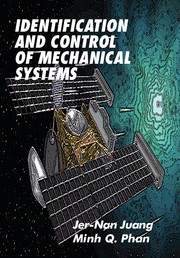Book contents
- Frontmatter
- Contents
- Preface
- 1 Ordinary Differential Equations
- 2 Elementary Matrix Algebra
- 3 Modeling Techniques
- 4 Finite-Element Method
- 5 Response of Dynamic Systems
- 6 Virtual Passive Controllers
- 7 State–Space Models
- 8 State-Feedback Control
- 9 Dynamic Feedback Controller
- 10 System Identification
- 11 Predictive Control
- Index
4 - Finite-Element Method
Published online by Cambridge University Press: 02 September 2009
- Frontmatter
- Contents
- Preface
- 1 Ordinary Differential Equations
- 2 Elementary Matrix Algebra
- 3 Modeling Techniques
- 4 Finite-Element Method
- 5 Response of Dynamic Systems
- 6 Virtual Passive Controllers
- 7 State–Space Models
- 8 State-Feedback Control
- 9 Dynamic Feedback Controller
- 10 System Identification
- 11 Predictive Control
- Index
Summary
Introduction
In the analysis of continuous systems, the formulations describing the system response are governed by partial differential equations, as presented in the last chapter. The exact solution of the partial differential equations satisfying all boundary conditions is possible for only relatively simple systems such as a uniform beam. Numerical procedures must be used to approximate the partial differential equations and predict the system response.
The finite-element method is a very popular technique for the numerical solution of complex problems in engineering. It is a technique for solving partial differential equations that represent a physical system by discretizing them in their space dimensions. The discretization is performed locally over small regions of simple but arbitrary shape, i.e., finite elements. For example, in structural engineering, a structure is typically represented as an assemblage of discrete truss and beam elements. The discretization process converts the partial differential equations into matrix equations relating the input at specified points in the elements to the output at these same points. To solve equations over large regions, the matrix equations for the smaller subregions are summed node by node to yield global matrix equations.
Our objective in this chapter is to present the fundamental principles of the finite-element method. It is not our goal to summarize all the finite-element formulations available, but rather to establish only the basic and general principles that provide the foundation for a preliminary understanding of the finite-element method.
Information
- Type
- Chapter
- Information
- Identification and Control of Mechanical Systems , pp. 80 - 119Publisher: Cambridge University PressPrint publication year: 2001
